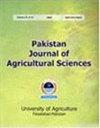Investigating the antioxidative properties and volatile profile of microwave assisted black cumin seed extracts
IF 0.6
4区 农林科学
Q3 AGRICULTURE, MULTIDISCIPLINARY
引用次数: 0
Abstract
Present study was aimed to assess the effect of microwave assisted extraction on total phenolic contents (TPC), total flavonoid contents (TFC), in-vitro antioxidant characteristics and identification of major volatile components of black cumin seeds extracted using different solvents (ethanol, n-hexane and water). Variation in TPC (28.72 – 37.15 mg GAE/g) and TFC (24.96 – 32.13 mg QE/g) of microwave assisted black cumin extracts (MABCEs) using different solvents was observed. Concurrently, the in-vitro antioxidant capacity varied from 63.34 to 82.12%, 119.82 to 168.0 µM Fe (II)/100mg, and 30.73 to 52.46% as analysed by DPPH, FRAP and β-carotene bleaching assays, respectively. Microwave-assisted extraction showed significantly higher results of TPC, TFC, and in-vitro antioxidant characterization as compared to control (non-microwave assisted). Depending upon the results of these in-vitro analyses, n-hexane extract was further employed to Gas Chromatographic analysis. Among all the 25 phenolic compounds identified, p-cymene, thymoquinone, carvacrol, α- thujene, 4-isopropyl-9-methoxy1methyl-1-cyclohexene and longifolene were reported to be 26.97%, 35.91%, 2.19%, 8.26%, 5.45% and 4.98%, respectively. Therefore, it is concluded that microwave assisted extraction technique is more efficient as compared to conventional extraction techniques keeping in view the antioxidant properties and volatile profiling.微波辅助黑孜然籽提取物的抗氧化性能和挥发性研究
本研究旨在评估微波辅助提取对不同溶剂(乙醇、正己烷和水)提取的黑孜然种子的总酚含量(TPC)、总黄酮含量(TFC)、体外抗氧化特性和主要挥发性成分鉴定的影响。观察到使用不同溶剂的微波辅助黑孜然提取物(MABCEs)的TPC(28.72–37.15 mg GAE/g)和TFC(24.96–32.13 mg QE/g)的变化。同时,通过DPPH、FRAP和β-胡萝卜素漂白分析,体外抗氧化能力分别为63.34%至82.12%、119.82至168.0µM Fe(II)/100mg和30.73%至52.46%。与对照(非微波辅助)相比,微波辅助提取显示出显著更高的TPC、TFC和体外抗氧化特性结果。根据这些体外分析的结果,正己烷提取物被进一步用于气相色谱分析。在鉴定的25种酚类化合物中,对cymene、胸腺肽醌、香芹酚、α-thujene、4-异丙基-9-甲氧基-1-甲基-1-环己烯和长叶烯的含量分别为26.97%、35.91%、2.19%、8.26%、5.45%和4.98%。因此,从抗氧化性能和挥发性特征来看,与传统提取技术相比,微波辅助提取技术更有效。
本文章由计算机程序翻译,如有差异,请以英文原文为准。
求助全文
约1分钟内获得全文
求助全文
来源期刊

Pakistan Journal of Agricultural Sciences
AGRICULTURE, MULTIDISCIPLINARY-
CiteScore
1.80
自引率
25.00%
发文量
18
审稿时长
6-12 weeks
期刊介绍:
Pakistan Journal of Agricultural Sciences is published in English four times a year. The journal publishes original articles on all aspects of agriculture and allied fields.
 求助内容:
求助内容: 应助结果提醒方式:
应助结果提醒方式:


